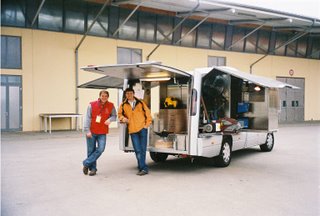

One of the most interesting products demonstrated at the Luwex Hufsympsium in Germany in October was what I called the “hoof lifter”, developed by Italian vet/farrier Hans Castilijns DVM, made in Italy, and demo’d by Swiss farrier Bernard Duvernay.
The horse stands on the device, which is covered with a rubber mat. It looks like that puck-like thing that curlers push around on the ice, with a three-foot handle and a protractor on the end. The operator stands one foot on the device and then stands back and slow raises the angle so that the horse is putting more and more pressure on the back of the foot as the coffin joint flexes.
After observing the horse, the operator than simply swivels the handle, without having to move the horse, and then can raise the lateral side of the device, tipping the foot to the medial side.
Accordingly, without moving the foot, the operator moves to the other side of the horse to test the lateral side.
The Europeans have always been keen on the hoof-lifting coffin-joint flexion tests for navicular pain, and this device gives expanded pain-response capabilities. It is well made and simple to use, but seems to keep the handler safe, too.







